

Atmina

Ask a doctor about a prescription for Atmina

How to use Atmina
Package Leaflet: Information for the Patient
Atmina, 4.6 mg/24 h, transdermal system, patch
Atmina, 9.5 mg/24 h, transdermal system, patch
Rivastigmine
Read the package leaflet carefully before using the medicine, as it contains important information for the patient.
- Keep this leaflet, you may need to read it again.
- If you have any further questions, ask your doctor or pharmacist.
- This medicine has been prescribed for you only. Do not pass it on to others. It may harm them, even if their symptoms are the same as yours.
- If you experience any side effects, including any not listed in this leaflet, tell your doctor or pharmacist. See section 4.
Table of Contents of the Leaflet
- 1. What is Atmina and what is it used for
- 2. Important information before using Atmina
- 3. How to use Atmina
- 4. Possible side effects
- 5. How to store Atmina
- 6. Contents of the pack and other information
1. What is Atmina and what is it used for
The active substance of Atmina is rivastigmine.
Rivastigmine belongs to a group of substances called cholinesterase inhibitors. In patients with Alzheimer's disease, certain nerve cells in the brain die, which reduces the amount of the neurotransmitter acetylcholine (a substance that allows nerve cells to communicate with each other). Rivastigmine works by blocking the enzymes that break down acetylcholine: acetylcholinesterase and butyrylcholinesterase.
By blocking the action of these enzymes, rivastigmine increases the amount of acetylcholine in the brain, which helps to alleviate the symptoms of Alzheimer's disease.
Atmina is used to treat adult patients with mild to moderately severe Alzheimer's disease, a progressive brain disease that causes gradual memory, intellectual, and behavioral disorders.
2. Important information before using Atmina
When not to use Atmina
Warnings and precautions
Before starting to use Atmina, discuss with your doctor or pharmacist:
If any of these situations apply to you, your doctor may monitor you more closely while you are using this medicine.
If you have not applied a patch for more than three days, you should not apply a new patch until you have talked to your doctor.
You should carefully remove all applied patches before applying a new one. Do not apply more than one patch at the same time. Applying several (or more than one) patches to the skin may expose you to an excessive amount of medicine, which can be dangerous.
Children and adolescents
Using Atmina in children and adolescents to treat Alzheimer's disease is not appropriate.
Atmina and other medicines
Tell your doctor or pharmacist about all medicines you are taking or have recently taken, as well as any medicines you plan to take.
Atmina may affect the action of anticholinergic medicines, some of which are used to relieve stomach cramps (e.g., dicyclomine), to treat Parkinson's disease (e.g., amantadine) or to prevent motion sickness (e.g., diphenhydramine, scopolamine, or meclizine).
Atmina transdermal system, patch should not be used at the same time as metoclopramide (a medicine used to relieve or prevent nausea and vomiting).
Taking these two medicines together may cause disorders such as stiffness of the limbs and hand tremors.
If you are going to have surgery while using Atmina transdermal system, patch, you should tell your doctor that you are using it, as it may increase the action of some muscle relaxants given during anesthesia.
Caution should be exercised when Atmina transdermal system, patch is used with beta-adrenergic blockers (medicines such as atenolol, used to treat high blood pressure, angina pectoris, and other heart diseases). Taking these two medicines together may cause disorders such as slow heart rate (bradycardia), leading to fainting or loss of consciousness.
Caution should be exercised when Atmina is used with other medicines that may affect heart rate or cardiac conduction (prolonged QT interval).
Pregnancy, breastfeeding, and fertility
If you are pregnant or breastfeeding, think you may be pregnant, or plan to have a baby, ask your doctor or pharmacist for advice before using this medicine.
If you are pregnant, your doctor will assess the benefits of using Atmina against the possible effects of the medicine on the unborn baby. Atmina should not be used during pregnancy unless it is absolutely necessary.
You should not breastfeed while using Atmina.
Driving and using machines
Your doctor will tell you whether your condition allows you to drive and use machines. Atmina transdermal system, patch may cause fainting or severe confusion. If you feel weak or disoriented, you should not drive, operate machinery, or perform other tasks that require concentration.
3. How to use Atmina
Always use this medicine exactly as your doctor has told you. If you are not sure, ask your doctor or pharmacist.
How to start treatment
Your doctor will tell you which Atmina patch is best for you.
- Treatment usually starts with Atmina 4.6 mg/24 h.
- The recommended, usually used daily dose of Atmina is 9.5 mg/24 h. If this dose is well tolerated, your doctor may consider increasing the dose to 13.3 mg/24 h. It is not possible to achieve a dose of 13.3 mg/24 h with Atmina. In cases of diseases that require the use of such a dose, other transdermal systems containing rivastigmine 13.3 mg/24 h are available.
- You should apply only onerectangular patch and one oval, self-adhesive protective cover at a time (as described in detail below) and you should change them to new ones twice a week, at the latest after 4 days. You should change the patches on two fixed days:
In each
Monday and Friday OR
Tuesday and Saturday OR
Wednesday and Sunday OR
Thursday and Monday OR
Friday and Tuesday OR
Saturday and Wednesday OR
Sunday and Thursday.
You should always apply a new patch at the same time of day. To help you remember, you should note the days and time of patch change.
During treatment, your doctor may adjust the dose of Atmina to your individual needs.
If you have not applied a patch for more than three days, you should not apply a new patch until you have talked to your doctor. Patch treatment can be resumed using the same dose if the treatment interruption did not exceed three days. Otherwise, your doctor will recommend resuming treatment with a dose of 4.6 mg/24 h Atmina.
Atmina can be used with food, drink, and alcohol.
Where to apply Atmina, transdermal system, patch
Before applying the patch, make sure the skin in the planned application area is clean, dry, and hairless, free from powder, oils, moisturizing creams, or liquids that could prevent the patch from sticking properly, free from cuts, rash, and/or irritation.
- Always carefully remove all applied patches before applying a new one.Applying several patches to the skin may expose you to an excessive amount of medicine, which can be dangerous.
- You should apply ONErectangular patch together with one self-adhesive protective cover to ONLY ONEof the following areas, as shown in the diagrams below:
- upper part of the left arm orupper part of the right arm
- upper part of the chest on the left side oron the right side (you should avoid applying patches to the breast)
- upper part of the back on the left side oron the right side
- lower part of the back on the left side oron the right side.
No later than 4 days after, you should remove the previous patch before applying ONEnew patch and one self-adhesive protective cover to ONLY ONEof the following possible areas.
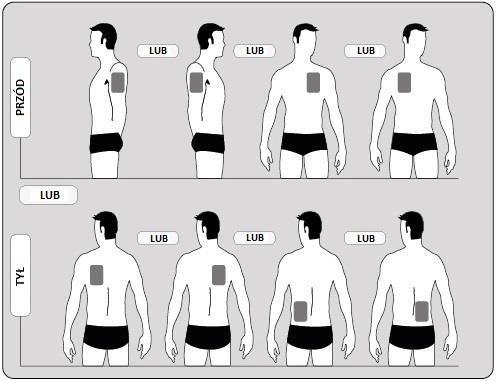
When changing the patch, you should remove the previous patch before applying a new patch in a different area (e.g., 4 days on the right side of the body, then 3 days on the left side, and 4 days on top, and then 3 days on the bottom). You should not apply a patch to the same area within 14 days.
How the patient should apply Atmina, transdermal system, patch
Atmina is intended for transdermal use.
Atmina consists of two parts:
- one rectangular, semi-transparent patch containing the active substance (transdermal system), which is in a sealed pouch and
- one oval, beige patch made of fabric that does not contain the active substance (self-adhesive protective cover), which is also in a sealed pouch. This pouch is larger than the pouch containing the transdermal system, patch.
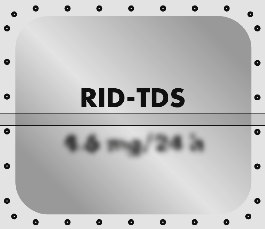 | 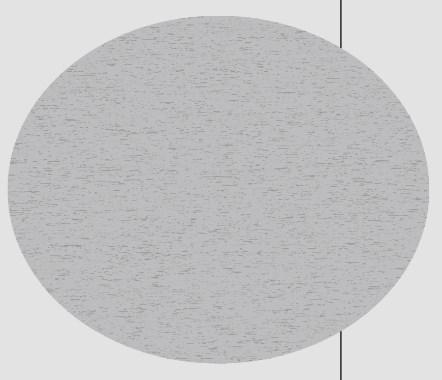 |
| Transdermal system, patch containing the active substance | Fabric patch without active substance (for fixation) |
Do not open the pouch or remove the patch from the pouch until you are ready to apply it to the skin.
Always apply the rectangulartransdermal system, patch first.
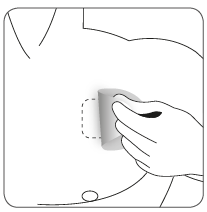 | Carefully remove the previous patch before applying a new one. Patients starting treatment (for the first time) and patients resuming treatment with rivastigmine after a break should start with the actions shown in the second diagram. |
 | Each patch is in a separate, sealed pouch. The pouch should be opened just before using the patch. Cut the pouch at the two points marked with scissors, but no further than the indicated line. Tear the pouch to open it. Do not cut the pouch along its entire length to avoid damaging the patch. Remove the rectangular, semi-transparent transdermal system, patch from the pouch. |
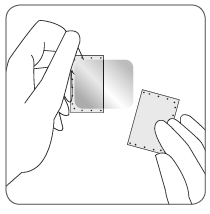 | The adhesive layer of the patch is protected by a protective layer. Remove one part of the protective layer without touching the adhesive surface of the patch with your fingers. |
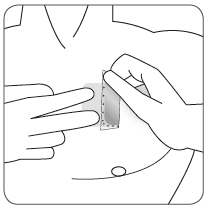 | Apply the adhesive surface of the patch to the upper or lower part of the back, upper part of the arm, or chest, and then remove the second part of the protective layer. |
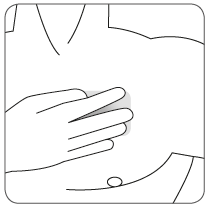 | Press the patch firmly with your hand for about 15 seconds, making sure its edges are well stuck to the skin. |
Then apply the oval, self-adhesive protective cover.
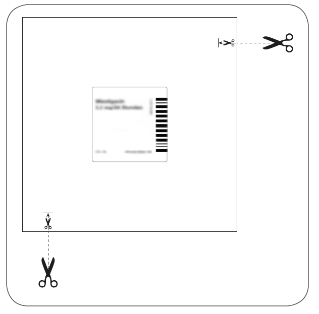 | Cut the pouch at the two points marked with scissors, but no further than the indicated line. Tear the pouch to open it. Do not cut the pouch along its entire length to avoid damaging the self-adhesive protective cover without active substance. Remove the oval, beige, self-adhesive protective cover from the pouch. |
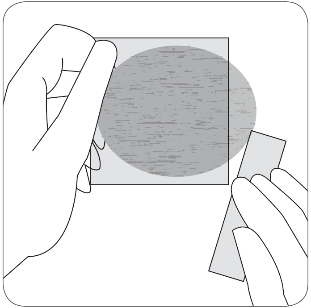 | The adhesive layer of the protective cover is protected by a protective layer. Remove the smaller part of the protective layer without touching the adhesive surface of the patch with your fingers. |
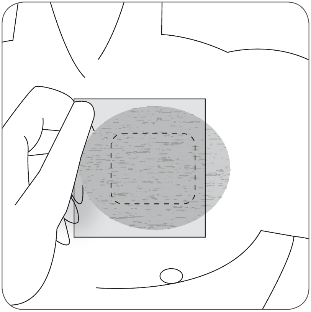 | Apply the adhesive surface of the protective cover to the previously applied transdermal system, patch, so that it is completely covered, and then remove the second part of the protective layer. |
 | Press the patch firmly with your hand for at least 30 seconds, making sure its edges are well stuck to the skin. |
For some patients, it may be helpful to write the day of the week with a fine pen on the protective cover, e.g., the day of the week.
The patch should be worn continuously until it is time to change it. You can try different application sites for the new patch to choose the most convenient and least exposed to abrasion by clothing.
How the patient should remove Atmina, transdermal system, patch
Gently pull one edge of the self-adhesive protective cover and slowly peel it off the skin together with the transdermal system.
If the transdermal system remains on the skin, gently pull one edge and peel it off the skin.
If there are any adhesive residues on the skin, they can be removed by washing the area with warm water and mild soap or baby oil. Do not use alcohol or other solvents (nail polish remover and other products).
After removing the patch, wash your hands with soap and water. If the medicine comes into contact with your eyes or if you experience eye irritation after contact with the patch, immediately rinse your eyes with plenty of water, and if the symptoms do not disappear, seek medical attention.
Can the patient use Atmina, transdermal system, patch during bathing, swimming, or in the sun?
- Bathing, swimming, or showering should not affect the action of the patch. You should make sure that the patch is not loosened during these activities.
- You should not expose the patch to prolonged external heat sources (e.g., excessive sun exposure, sauna, solarium).
What to do if the patch comes off
If the patch comes off, you should apply a new one and then change it at the usual time.
When and for how long should the patient use Atmina, transdermal system, patch?
- To make the treatment effective, you should apply a new patch twice a week, at the latest after 4 days, preferably at the same time of day.
You should apply only one rectangular transdermal system, patch and one oval, self-adhesive protective cover at a time and you should change them to new ones on two fixed days of the week.
- You should apply only one rectangular transdermal system, patch and one oval, self-adhesive protective cover at a time and you should change them to new ones on two fixed days of the week.
Using more than the recommended dose of Atmina
If you accidentally apply more than one rectangulartransdermal system, patch, you should remove all patches and then tell your doctor about the accidental application of more than one patch. You may need medical attention. In some people who have accidentally taken too much rivastigmine, nausea (nausea), vomiting, diarrhea, high blood pressure, and hallucinations have occurred. Slow heart rate and fainting may also occur.
Missing a dose of Atmina
If you find that you have forgotten to apply a patch, you should do so immediately, provided that the treatment interruption does not exceed three days.
The next patch can be applied at the usual time on the fixed day, to return to the usual dosing schedule. You should not apply two patches to make up for a missed patch. If you have not had a patch on for more than three days, you should not apply a new patch until you have talked to your doctor.
Stopping treatment with Atmina
If you stop using the patches, you should tell your doctor or pharmacist.
If you have any further questions about using this medicine, ask your doctor or pharmacist.
4. Possible side effects
Like all medicines, this medicine can cause side effects, although not everybody gets them.
Side effects may occur more frequently during the initial period of using the medicine or during dose escalation. Side effects usually disappear slowly as the body gets used to the treatment.
If you experience any of the following side effects, remove the patch and tell your doctor immediately, as these effects can be severe:
Frequent(may occur in less than 1 in 10 people)
- loss of appetite
- dizziness
- agitation or drowsiness
- urinary incontinence (inability to properly retain urine).
Uncommon(may occur in less than 1 in 100 people)
- heart rhythm disorders, such as slow heart rate
- seeing things that are not there (hallucinations)
- stomach ulcers
- dehydration (loss of too much fluid)
- excessive restlessness (high level of activity, restlessness)
- aggression.
Rare(may occur in less than 1 in 1000 people)
- falls.
Very rare(may occur in less than 1 in 10,000 people)
- stiffness of the arms or legs
- hand tremors.
Frequency not known(frequency cannot be estimated from the available data)
- allergic reaction at the patch application site, such as blisters or skin inflammation
- worsening of Parkinson's disease symptoms, such as tremors, stiffness, or dragging of the legs
- pancreatitis - symptoms include severe abdominal pain, often with nausea (nausea) or vomiting
- rapid or irregular heartbeat
- high blood pressure
- seizures (epileptic fits)
- liver function disorders (jaundice, yellowing of the whites of the eyes, unusual dark color of urine or unexplained nausea, vomiting, fatigue, and loss of appetite)
- changes in liver function test results
- restlessness
- nightmares
- Pisa syndrome (a condition involving involuntary muscle contraction with abnormal tilting of the body and head to one side).
If you experience any of these side effects, remove the patch and tell your doctor immediately.
Other side effects reported after using rivastigmine in capsule or oral solution form, which may also occur after using patches:
Frequent(may occur in less than 1 in 10 people)
- excessive salivation
- loss of appetite
- restlessness
- general malaise
- tremors or confusion
- excessive sweating.
Uncommon(may occur in less than 1 in 100 people)
- heart rhythm disorders (e.g., rapid heartbeat)
- difficulty sleeping
- accidental falls.
Rare(may occur in less than 1 in 1000 people)
- seizures (epileptic fits)
- intestinal ulcers
- chest pain - may be caused by a heart attack.
Very rare(may occur in less than 1 in 10,000 people)
- high blood pressure
- pancreatitis - symptoms include severe abdominal pain, often with nausea (nausea) or vomiting
- gastrointestinal bleeding - blood in stool or vomit
- seeing things that are not there (hallucinations)
- severe vomiting that can lead to a tear in the esophagus (the tube connecting the mouth to the stomach).
Reporting side effects
If you experience any side effects, including any not listed in this leaflet, tell your doctor or pharmacist. Side effects can be reported directly to the Department of Drug Safety Monitoring, Office for Registration of Medicinal Products, Medical Devices, and Biocidal Products; Al. Jerozolimskie 181C, 02-222 Warsaw, tel.: +48 22 49 21 301, fax: +48 22 49 21 309, website: https://smz.ezdrowie.gov.pl.
Side effects can also be reported to the marketing authorization holder.
By reporting side effects, you can help provide more information on the safety of this medicine.
5. How to store Atmina
- Keep this medicine out of the sight and reach of children.
- Do not use this medicine after the expiry date stated on the carton and pouch after “Expiry date” (EXP). The expiry date refers to the last day of the month stated.
- There are no special storage instructions for this medicine.
- Do not use a patch that is damaged or shows signs of opening.
After removing the patch, fold it in half with the adhesive side inwards and press firmly. Put the used patch in the pouch and then dispose of it in a place that is out of the reach of children. Medicines should not be disposed of via wastewater or household waste. Ask your pharmacist how to dispose of medicines that are no longer needed. This will help protect the environment.
6. Contents of the pack and other information
What Atmina contains
The active substance is rivastigmine.
Atmina 4.6 mg/24 h, transdermal system, patch:
Each transdermal system, patch releases 4.6 mg of rivastigmine over 24 hours. Each transdermal system, patch with a surface area of 10.8 cm contains 25.92 mg of rivastigmine.
Atmina 9.5 mg/24 h, transdermal system, patch:
Each transdermal system, patch releases 9.5 mg of rivastigmine over 24 hours. Each transdermal system, patch with a surface area of 21.6 cm contains 51.84 mg of rivastigmine.
The other ingredients are:
Outer layer (covering): polyethylene terephthalate film.
Active layer: tocopherol, poly(2-ethylhexyl acrylate, vinyl acetate) (1:1), butyl acrylate, and butyl methacrylate copolymer.
Membrane permeable to the active substance: polyethylene film.
Adhesive layer: polyisobutylene with medium molecular weight, polyisobutylene with high molecular weight, polybutylene with high molecular weight.
Protective layer (removable): siliconized polyester film.
Printing ink: blue ink.
What Atmina looks like and contents of the pack
Each transdermal system is a thin, rectangular patch with rounded corners.
The patch is semi-transparent and has the following markings:
Atmina, 4.6 mg/24 h, transdermal system, patch: RID-TDS 4.6 mg/24 h
Atmina, 9.5 mg/24 h, transdermal system, patch: RID-TDS 9.5 mg/24 h
Each transdermal system, patch is in a separate, sealed pouch. The pouches are marked as follows:
Atmina, 4.6 mg/24 h, transdermal system, patch
Atmina, 9.5 mg/24 h, transdermal system, patch
In addition, each carton containing the transdermal system, patch has a protective cover for fixing the transdermal system, patch.
Each protective cover is a thin, beige, oval patch.
The protective covers are in separate, sealed pouches. The pouches are marked as follows:
Self-adhesive protective cover without active substance.
The whole is in a carton.
Atmina, 4.6 mg/24 h, transdermal system, patchand Atmina, 9.5 mg/24 h, transdermal system, patch
are available in packs containing 2, 8, 16, or 24 transdermal systems, patches with 2, 8, 16, or 24 self-adhesive protective covers, respectively.
Not all pack sizes may be marketed.
Marketing authorization holder and manufacturer
Marketing authorization holder
Exeltis Poland Sp. z o.o.
ul. Szamocka 8
01-748 Warsaw
e-mail: [email protected]
Manufacturer
Luye Pharma AG
Am Windfeld 35
83714 Miesbach
Germany
This medicine is authorized in the Member States of the European Economic Area under the following names:
Spain
Alzerta dos por semana 4.6 mg/24 h patches transdermicos
Alzerta dos por semana 9.5 mg/24 h patches transdermicos
Germany
Rivez zweimal wöchentlich 4.6 mg/24 Stunden Transdermales Pflaster
Rivez zweimal wöchentlich 9.5 mg/24 Stunden Transdermales Pflaster
Poland
Atmina
Date of last revision of the leaflet:06.12.2024
- Country of registration
- Active substance
- Prescription requiredYes
- Manufacturer
- ImporterLuye Pharma AG
- This information is for reference only and does not constitute medical advice. Always consult a licensed doctor before taking any medication. Oladoctor is not responsible for medical decisions based on this content.
- Alternatives to AtminaDosage form: System, 9.5 mg/24 hActive substance: rivastigmineManufacturer: Luye Pharma AGPrescription requiredDosage form: System, 4.6 mg/24 hActive substance: rivastigminePrescription requiredDosage form: System, 9.5 mg/24 hActive substance: rivastigmineManufacturer: Luye Pharma AG Zentiva SAPrescription required
Alternatives to Atmina in other countries
The best alternatives with the same active ingredient and therapeutic effect.
Alternative to Atmina in Hiszpania
Alternative to Atmina in Ukraina
Online doctors for Atmina
Discuss dosage, side effects, interactions, contraindications, and prescription renewal for Atmina – subject to medical assessment and local rules.











